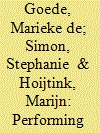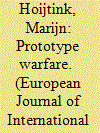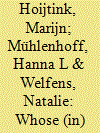|
|
|
Sort Order |
|
|
|
Items / Page
|
|
|
|
|
|
|
| Srl | Item |
| 1 |
ID:
134475


|
|
|
|
|
| Summary/Abstract |
In recent years, the European Union has supported the development of a new civil security market, capable of providing security technology for new and global security challenges. This article analyses the emerging growth market for civil security in relation to contemporary notions of potential crisis and emergency. Building on ongoing academic analysis of what Melinda Cooper has termed ‘economies of emergence’, the article points out how the figure of emergence generates investment in more flexible, adaptive and, so it is argued, potentially lucrative markets for civil security. Drawing on observations at a number of security trade shows and stakeholder workshops, the analysis demonstrates that ‘civil’ aspirations, concepts and technologies build on earlier formulations of military strategic discourse in the so-called Revolution in Military Affairs – though in complex and sometimes contradictory ways. More generally, the motivation behind the analysis is to investigate civil security and civil markets as performative enactments, and so to critically engage with the emergence of the civil security market as a priority in EU policymaking.
|
|
|
|
|
|
|
|
|
|
|
|
|
|
|
|
| 2 |
ID:
155148


|
|
|
|
|
| Summary/Abstract |
This paper provides a detailed study of the liquid bomb plot from 2006, focusing on the ways in which the plot was constituted as “an event unlike others” (Adey, Anderson, and Lobo Guerrero 2011, 340). Engaging with a critical body of scholarship that examines how events are assembled and governed as emergencies, disasters, or catastrophes, the paper explores two sets of questions. First, the paper engages with the temporal dimension of the event, asking how the liquid bomb plot was mediated as a particularly risky event that required immediate action. Second, the paper focuses on the spatial dimension of the event and asks how the plot also threatened a seemingly interconnected system of global airline movements and a mobile form of life. Drawing on Cowen’s (2010) analysis of the “seam space,” I am particularly interested in developments of reform and experimentation at the airport and in how newly emerging technologies are targeted at keeping airports both secure and open. Ultimately, by examining the liquid bomb plot “in the middle of events” (Barry 2006, 244), the paper goes beyond an understanding of the security event as something that happens abruptly and by surprise, and sheds light on the ongoing work that is involved in constituting and governing events.
|
|
|
|
|
|
|
|
|
|
|
|
|
|
|
|
| 3 |
ID:
134472


|
|
|
|
|
| Summary/Abstract |
Nearly 15 years after 9/11, it is time to grapple with the way in which imperatives of preemption have made their way into routine security practice and bureaucratic operations. As a growing literature in security studies and political geography has argued, preparing for catastrophe, expecting the worst, and scripting disasters are central elements of contemporary, speculative security culture. One of the most-discussed findings of the 9/11 Commission Report was that US security services had insufficiently deployed their imagination to foresee and preempt the attacks. This article introduces a special issue that offers a range of in-depth empirical studies that analyse how the imperative of ‘routinizing the imagination’ plays out in practice across different policy domains. It deploys the lens of performativity in order to conceptualize and explain the materialization of preemption and its situated entanglements with pre-existing security bureaucracies. We detail the idealized traits of a ‘security of the interstice’, which include interoperability, emergence, flexibility and analytical foresight that are meant to bridge the perceived gaps of security spaces and the temporal bridges between present and possible futures. The lofty rhetoric of preparing for the worst and bridging the gaps encounters numerous obstacles, challenges and reversals in practice. As becomes clear through the notion of performativity, such obstacles and challenges do not just ‘stand in the way’ of implementation, but actively shape the materialization of preemption in different sectors.
|
|
|
|
|
|
|
|
|
|
|
|
|
|
|
|
| 4 |
ID:
185827


|
|
|
|
|
| Summary/Abstract |
In recent years, the concept of ‘prototype warfare’ has been adopted by Western militaries to accelerate the experimental development, acquisition, and deployment of emerging technologies in warfare. Building on scholarship at the intersection of Science and Technology Studies and International Relations investigating the broader discursive and material infrastructures that underpin contemporary logics of war, and taking a specific interest in the relationship between science, technology, and war, this article points out how prototype warfare captures the emergence of a new regime of warfare, which I term the experimental way of warfare. While warfare has always been defined by experimental activity, what is particular in the current context is how experimentation spans across an increasingly wide range of military practices, operating on the basis of a highly speculative understanding of experimentation that embraces failure as a productive force. Tracing the concept of prototype warfare across Western military discourse and practice, and zooming in on how prototype warfare takes experimentation directly into the battlefield, the article concludes by outlining how prototype warfare reconfigures and normalises military intervention as an opportunity for experimentation, while outsourcing the failures that are a structural condition of the experimental way of warfare to others, ‘over there’.
|
|
|
|
|
|
|
|
|
|
|
|
|
|
|
|
| 5 |
ID:
193141


|
|
|
|
|
| Summary/Abstract |
Building on feminist and postcolonial theoretical approaches across International Relations (IR) and security studies, this Special Issue advances an emerging research agenda within EU studies by shedding light on the gendered and racialised logics of EU security and their links to colonial histories and practices. Together, the contributions to this Special Issue demonstrate how EU security is intrinsically connected to and constituted by histories of colonialism, racism and patriarchy. At the same time, they also highlight how the colonial, racialised and gendered dynamics that underpin EU security and that are mobilised by the EU, its institutions and member states are always complex and shifting. Importantly, they do so by decentring our analysis of EU security moving our focus often away from the EU and towards different, somewhat unexpected sites and geographical locations of EU security. The current war in Ukraine underwrites the need for more historical, contextual and decentred work on EU security, while also highlighting the necessity to reflect on dominant practices of knowledge production and the experiences of people living in and with war through a feminist and postcolonial lens.
|
|
|
|
|
|
|
|
|
|
|
|
|
|
|
|
|
|
|
|
|